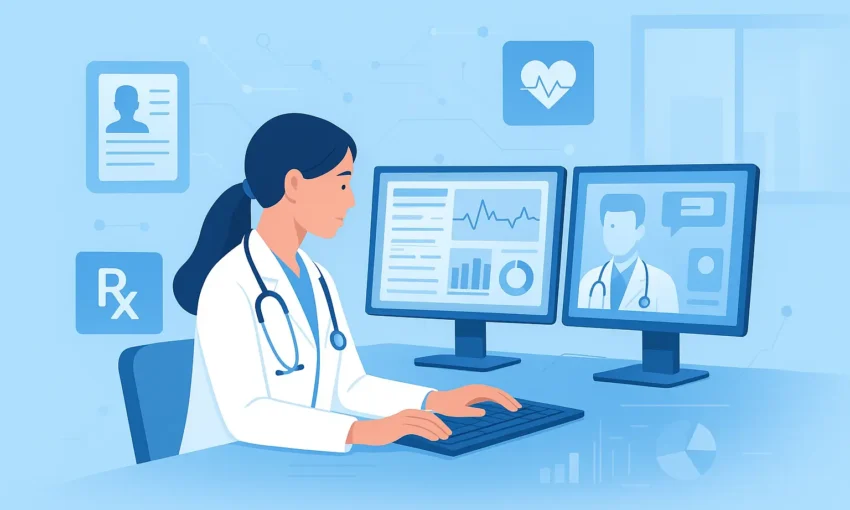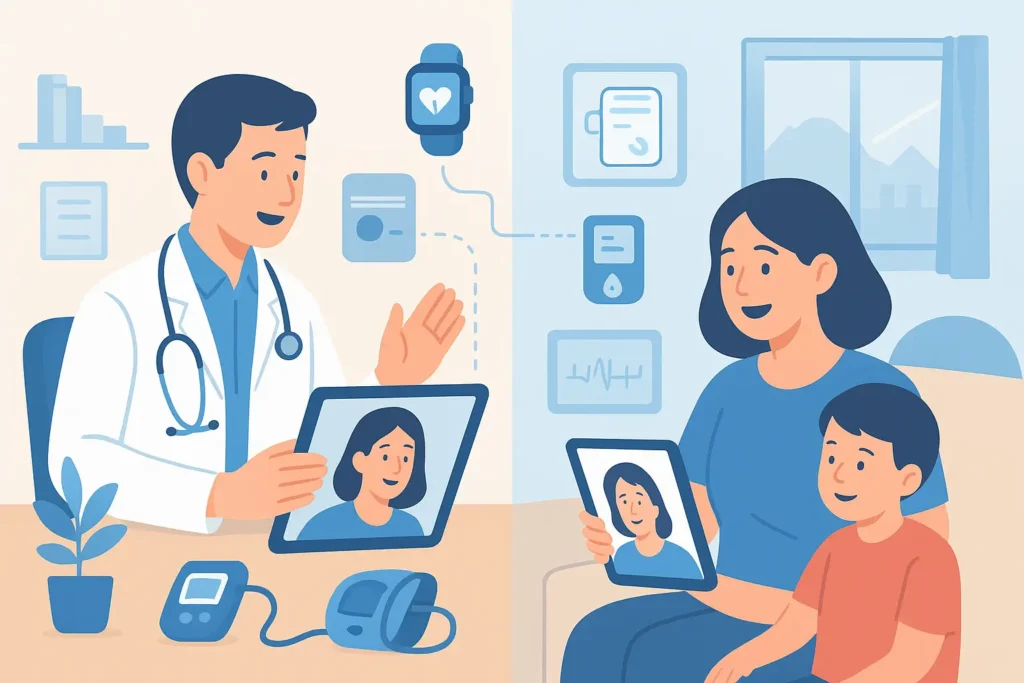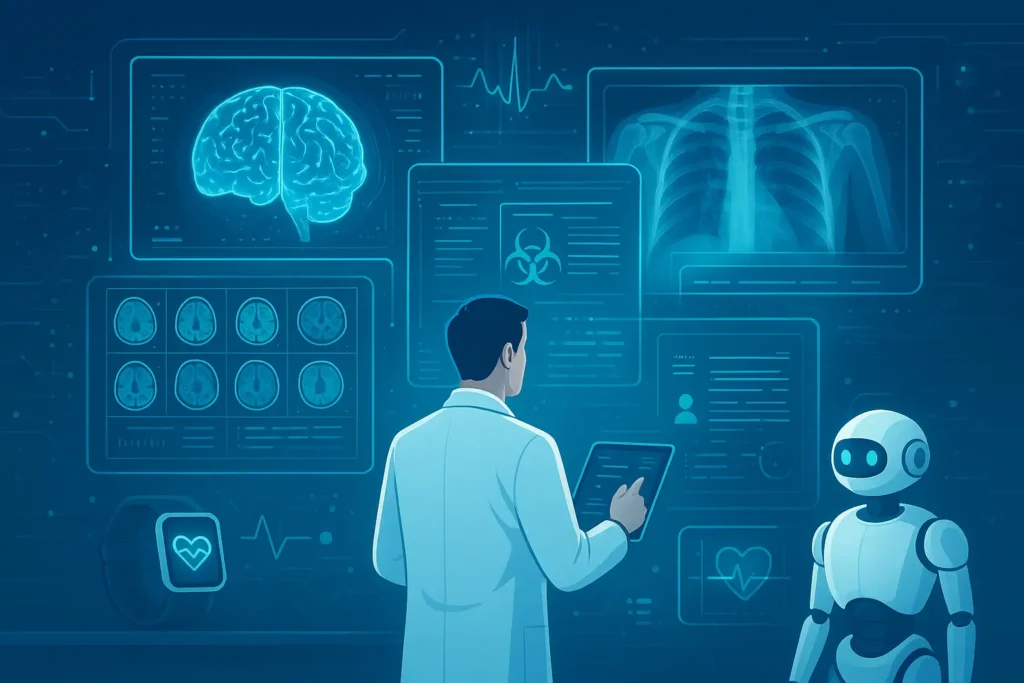10 Essential Healthcare Software Solutions Every Medical Practice Needs in 2025

The healthcare industry is experiencing a digital revolution that’s fundamentally changing how medical professionals deliver care. With the global healthcare IT market reaching new heights and projected to hit $834.35 billion by 2029, healthcare software solutions have become essential tools for modern medical practices.
Healthcare providers are no longer just treating patients – they’re managing complex digital ecosystems that improve patient outcomes, reduce costs, and streamline operations. These technological advances are making healthcare more accessible, efficient, and personalized than ever before.
Why Healthcare Software Solutions Matter More Than Ever
The shift toward digital healthcare isn’t just a trend – it’s a necessity. Medical professionals are dealing with increased patient volumes, complex regulatory requirements, and the need for better coordination across different care providers. Traditional paper-based systems simply can’t keep up with these demands.
The global healthcare IT market was valued at $368.15 billion in 2023 and is projected to grow at a CAGR of 14.7%, reaching $420.23 billion in 2024 and $834.35 billion by 2029. This explosive growth reflects the critical role that technology plays in modern healthcare delivery.
The Top 10 Healthcare Software Solutions Shaping 2025
1. Electronic Health Records (EHR) Systems
EHR systems have become the backbone of modern healthcare operations. These comprehensive platforms store patient information, medical histories, medications, and treatment plans in a centralized digital format. Unlike traditional paper records, EHR systems allow healthcare providers to access patient data instantly from anywhere.
Modern EHR systems go beyond basic record-keeping. They include features like clinical decision support, automated alerts for drug interactions, and integration with laboratory systems. Popular EHR platforms like Epic, Cerner, and athenahealth are continuously evolving to meet the changing needs of healthcare providers.
The real power of EHR systems lies in their ability to improve care coordination. When a patient visits multiple specialists or changes healthcare providers, their complete medical history follows them, ensuring continuity of care and reducing the risk of medical errors.

2. Telemedicine and Virtual Care Platforms
The advent of virtual visits and remote monitoring has occurred so rapidly that the market is projected to be over $160.13 billion by the end of 2025. Telemedicine has changed access to healthcare for patients, especially for those living in rural parts of the country or when a situation constitutes an emergency.
Telemedicine platforms allow healthcare providers to offer video consultations, remotely monitor key vital signs, and manage a patient’s prescriptions digitally. Patients can receive the same quality of care that they would in-person from the comfort of their home, while healthcare providers can offer their services to more patients.
Telemedicine was introduced before COVID-19, but the pandemic certainly accelerated its use and acceptance as a viable option for patients and healthcare providers. However, the potential for telemedicine and virtual care goes far beyond the pandemic alone. Almost 90% of respondents indicated that the investment in virtual care and connected care will represent a significant segment of their business strategy by 2025. This encompasses not only chronic disease management and mental health services but also routine follow-up appointments.
3. AI-Powered Diagnostic Tools
Artificial intelligence is changing the face of medical diagnostics. AI can provide faster, more accurate assessments of medical imaging, lab results, and patient symptoms. In the past couple of years, we have seen a rapid expansion of available AI technology, and with medical AI continuing to improve in 2025, we must expect more complex solutions including virtual health assistants.
AI diagnostic equipment can reveal patterns in images captured by imaging or laboratory results that might evade human eyes. AI-enabled diagnostic tools are at their best in cases such as radiology, pathology, and dermatology; areas where pattern recognition is vital to finding the medically correct diagnosis. The use of AI diagnostic aids do not replace healthcare providers, but supplement their ability to triangulate a diagnosis, allowing them to make decisions more confidently, and faster.
Machine learning algorithms constantly improve as they consume large datasets of medical information. This means AI-enabled diagnostic equipment will seem to provide a more complete solution over time that potentially maximizes accuracy, and reduces diagnostic error to improve patient health.
4. Remote Patient Monitoring (RPM) Systems
RPM systems enable health care providers to monitor patients’ vital signs, adherence to medication, and general health status at home, instead of in a clinical setting. RPM systems utilize wearable devices and applications, as well as connected medical devices, to collect data about the patient’s health in real-time.
For patients with chronic conditions such as diabetes, hypertension, and heart disease, RPM systems enable continuous monitoring, allowing the provider to catch problems before they occur. The provider can engage in early intervention, potentially reducing hospital readmissions and improving patient’s quality of life.
RPM systems have advanced considerably, with devices being more straightforward to use and becoming much less expensive. The modern RPM systems can monitor things such as blood glucose, pulse, pulse oximeter (oxygen saturation) and heart rhythm, so that the patient has fewer trips to the clinic and can manage their health at a distance.
5. Practice Management Software
Practice management software streamlines the administrative side of healthcare operations. These systems handle appointment scheduling, billing, insurance claims processing, and patient communication in one integrated platform.
Efficient practice management reduces wait times for patients and administrative burden on staff. Features like automated appointment reminders, online booking systems, and integrated billing help healthcare practices operate more smoothly and profitably.
Modern practice management software also includes analytics tools that help healthcare administrators make data-driven decisions about staffing, resource allocation, and business growth strategies.
6. Hospital Information Systems (HIS)
Hospital Information Systems encompass every part of the hospital, from patient admission to discharge. These full-scale platforms manage patient flow, bed assignment, medication administration, and department coordination.
HIS platforms provide hospitals with significant efficiency, allowing for instant visibility into hospital operations. Users are able to easily find available beds, track patient status (admitted, transferred, discharged), and coordinate care across numerous departments. Focused care across departments ultimately leads to shorter patient stays, lower costs, and happier patients.
The integration of modern HIS platforms allows them to connect to other systems across the healthcare ecosystem, creating a flow of information across the care continuum.
7. Revenue Cycle Management (RCM) Software
RCM software focuses on the financial aspects of healthcare delivery, managing everything from insurance verification to payment processing. These systems help healthcare providers optimize their revenue streams while reducing administrative costs.
Key features include automated insurance eligibility verification, claims processing, denial management, and patient billing. By streamlining these processes, RCM software reduces the time between service delivery and payment, improving cash flow for healthcare organizations.
Advanced RCM systems use predictive analytics to identify potential payment issues before they occur, allowing healthcare providers to address problems proactively and maximize revenue collection.
8. Laboratory Information Management Systems (LIMS)
Laboratory Information Management Systems handle laboratory processes including sample tracking to reporting results, ensuring that medical tests are processed accurately and in compliance with regulations.
Modern LIMS are integrated with Electronic Health Record systems and facilitate seamless ordering of tests and receiving results, minimizing errors and speeding up diagnosis. With the test results available when needed, healthcare providers can provide excellent patient care.
LIMS automate several processes and reduce manual errors. Features including barcode scanning at different stages, automated sample tracking, and electronic result reporting improve laboratory efficiency.
9. Pharmacy Management Systems
Pharmacy management systems handle medication dispensing, inventory management, and prescription processing. These systems are crucial for ensuring medication safety and managing pharmaceutical supply chains.
Key features include drug interaction checking, automated prescription refill reminders, and integration with prescriber systems. Modern pharmacy management systems also include telepharmacy capabilities, allowing pharmacists to provide services remotely.
The integration between pharmacy management systems and EHR platforms creates a closed-loop medication management system that improves patient safety and reduces medication errors.
10. Population Health Management Platforms
Population health management systems study health information from a large group of patients to identify trends, risk factors, and intervention opportunities. These systems can help healthcare organizations improve the health outcomes for an entire population of patients.
The use of advanced analytics functions allows for the identification of at-risk patients so the organization can proactively intervene in their healthcare. Additionally, the healthcare organization will have the opportunity to manage chronic disease programs and their prevention efforts using patient population analytics.
Systems that approach population health rather than individuals’ health can also help healthcare organizations improve community health outcomes and lessen overall community healthcare utilization costs.

The Future of Healthcare Software
The healthcare software landscape continues to evolve rapidly. Predictive analytics has been used in healthcare for decades, but we’ll see more examples of healthcare organizations piloting and embracing these AI solutions. Integration capabilities are becoming increasingly important as healthcare organizations seek to create seamless workflows across different systems.
Cloud-based solutions are becoming the standard, offering scalability, security, and cost-effectiveness. Mobile-first design ensures that healthcare providers can access critical information from anywhere, improving response times and patient care quality.
The focus is shifting toward patient-centered care, with software solutions designed to improve patient engagement and satisfaction. This includes patient portal systems, mobile health apps, and tools that enable patients to take a more active role in their healthcare journey.
FAQs
1. What is the most important healthcare software solution for small practices?
A: Electronic Health Records (EHR) systems are generally considered the most important initial investment a small practice can make for a more efficient, digitized method of providing patient care, compliance with regulated electronic record keeping, and will often have features such as appointment scheduling and basic billing solutions already integrated into the software. Many EHR systems now are specifically designed for small trading practices with affordable monthly licensing fees to host EHRs via a secure electronic cloud with no need for a large amount of IT resources to support the EHR use.
2. How do healthcare software solutions improve patient outcomes?
A: Healthcare software solutions improve patient outcomes in many ways: reduce medical errors by having current accurate patient data available; allow for better coordination of care between hospital based and community based providers; support clinical decision making using evidence based guideline recommendations; provide early intervention through remote monitoring using devices and predictive data analytics; and improved care for patients results in providing more personalized, timely and effective patient care.
3 Are healthcare software solutions secure and compliant with regulations?
A: Reputable healthcare software solutions are designed with security and compliance as top priorities. They must comply with regulations like HIPAA in the United States, which requires strict protection of patient health information. Modern healthcare software includes features like encryption, access controls, audit trails, and regular security updates. However, healthcare organizations must also implement proper security policies and staff training to ensure comprehensive protection of patient data.





